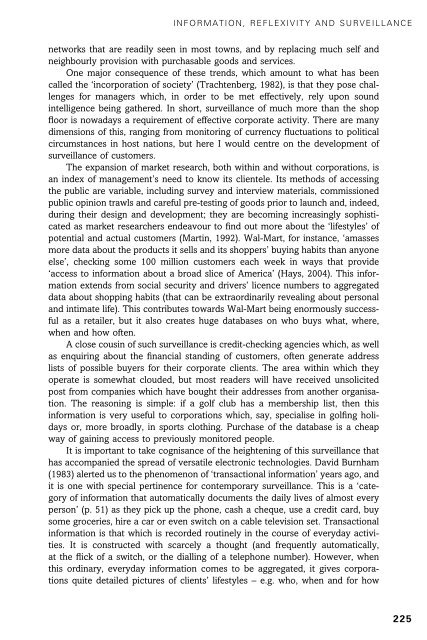Theories of the Information Society, Third Edition - Cryptome
Theories of the Information Society, Third Edition - Cryptome
Theories of the Information Society, Third Edition - Cryptome
You also want an ePaper? Increase the reach of your titles
YUMPU automatically turns print PDFs into web optimized ePapers that Google loves.
INFORMATION, REFLEXIVITY AND SURVEILLANCE<br />
1<br />
1<br />
1<br />
2<br />
1<br />
1<br />
networks that are readily seen in most towns, and by replacing much self and<br />
neighbourly provision with purchasable goods and services.<br />
One major consequence <strong>of</strong> <strong>the</strong>se trends, which amount to what has been<br />
called <strong>the</strong> ‘incorporation <strong>of</strong> society’ (Trachtenberg, 1982), is that <strong>the</strong>y pose challenges<br />
for managers which, in order to be met effectively, rely upon sound<br />
intelligence being ga<strong>the</strong>red. In short, surveillance <strong>of</strong> much more than <strong>the</strong> shop<br />
floor is nowadays a requirement <strong>of</strong> effective corporate activity. There are many<br />
dimensions <strong>of</strong> this, ranging from monitoring <strong>of</strong> currency fluctuations to political<br />
circumstances in host nations, but here I would centre on <strong>the</strong> development <strong>of</strong><br />
surveillance <strong>of</strong> customers.<br />
The expansion <strong>of</strong> market research, both within and without corporations, is<br />
an index <strong>of</strong> management’s need to know its clientele. Its methods <strong>of</strong> accessing<br />
<strong>the</strong> public are variable, including survey and interview materials, commissioned<br />
public opinion trawls and careful pre-testing <strong>of</strong> goods prior to launch and, indeed,<br />
during <strong>the</strong>ir design and development; <strong>the</strong>y are becoming increasingly sophisticated<br />
as market researchers endeavour to find out more about <strong>the</strong> ‘lifestyles’ <strong>of</strong><br />
potential and actual customers (Martin, 1992). Wal-Mart, for instance, ‘amasses<br />
more data about <strong>the</strong> products it sells and its shoppers’ buying habits than anyone<br />
else’, checking some 100 million customers each week in ways that provide<br />
‘access to information about a broad slice <strong>of</strong> America’ (Hays, 2004). This information<br />
extends from social security and drivers’ licence numbers to aggregated<br />
data about shopping habits (that can be extraordinarily revealing about personal<br />
and intimate life). This contributes towards Wal-Mart being enormously successful<br />
as a retailer, but it also creates huge databases on who buys what, where,<br />
when and how <strong>of</strong>ten.<br />
A close cousin <strong>of</strong> such surveillance is credit-checking agencies which, as well<br />
as enquiring about <strong>the</strong> financial standing <strong>of</strong> customers, <strong>of</strong>ten generate address<br />
lists <strong>of</strong> possible buyers for <strong>the</strong>ir corporate clients. The area within which <strong>the</strong>y<br />
operate is somewhat clouded, but most readers will have received unsolicited<br />
post from companies which have bought <strong>the</strong>ir addresses from ano<strong>the</strong>r organisation.<br />
The reasoning is simple: if a golf club has a membership list, <strong>the</strong>n this<br />
information is very useful to corporations which, say, specialise in golfing holidays<br />
or, more broadly, in sports clothing. Purchase <strong>of</strong> <strong>the</strong> database is a cheap<br />
way <strong>of</strong> gaining access to previously monitored people.<br />
It is important to take cognisance <strong>of</strong> <strong>the</strong> heightening <strong>of</strong> this surveillance that<br />
has accompanied <strong>the</strong> spread <strong>of</strong> versatile electronic technologies. David Burnham<br />
(1983) alerted us to <strong>the</strong> phenomenon <strong>of</strong> ‘transactional information’ years ago, and<br />
it is one with special pertinence for contemporary surveillance. This is a ‘category<br />
<strong>of</strong> information that automatically documents <strong>the</strong> daily lives <strong>of</strong> almost every<br />
person’ (p. 51) as <strong>the</strong>y pick up <strong>the</strong> phone, cash a cheque, use a credit card, buy<br />
some groceries, hire a car or even switch on a cable television set. Transactional<br />
information is that which is recorded routinely in <strong>the</strong> course <strong>of</strong> everyday activities.<br />
It is constructed with scarcely a thought (and frequently automatically,<br />
at <strong>the</strong> flick <strong>of</strong> a switch, or <strong>the</strong> dialling <strong>of</strong> a telephone number). However, when<br />
this ordinary, everyday information comes to be aggregated, it gives corporations<br />
quite detailed pictures <strong>of</strong> clients’ lifestyles – e.g. who, when and for how<br />
225
















